DACIA SANDERO STEPWAY 2016 2.G Owners Manual
Manufacturer: DACIA, Model Year: 2016, Model line: SANDERO STEPWAY, Model: DACIA SANDERO STEPWAY 2016 2.GPages: 174, PDF Size: 2.78 MB
Page 141 of 174
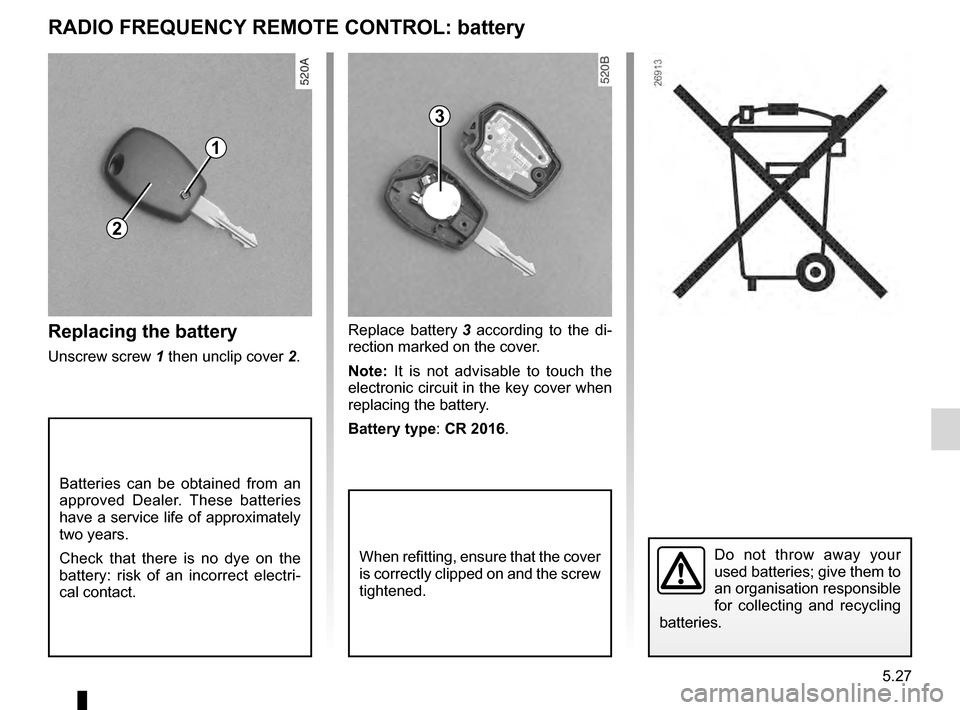
keysreplacing the battery ....................... (up to the end of the DU)
practical advice ..................................... (up to the end of the DU)
battery (remote control) ........................ (up to the end of the DU)
5.27
ENG_UD18258_8
Télécommande à radiofréquence : piles (B90 - U90 - L90 Ph2 \
- F90 Ph2 - R90 Ph2 - Dacia)
ENG_NU_817-10_B90_Dacia_5
Radio frequency remote control: battery
RADIO FREQUENCY REMOTE CONTROL: battery
Replacing the battery
Unscrew screw 1 then unclip cover 2 .Replace battery
3
according to the di-
rection marked on the cover.
Note: It is not advisable to touch the
electronic circuit in the key cover when
replacing the battery.
Battery type : CR 2016.
Batteries can be obtained from an
approved Dealer. These batteries
have a service life of approximately
two years.
Check that there is no dye on the
battery: risk of an incorrect electri-
cal contact.
Do not throw away your
used batteries; give them to
an organisation responsible
for collecting and recycling
batteries.
2
1
3
When refitting, ensure that the cover
is correctly clipped on and the screw
tightened.
Page 142 of 174
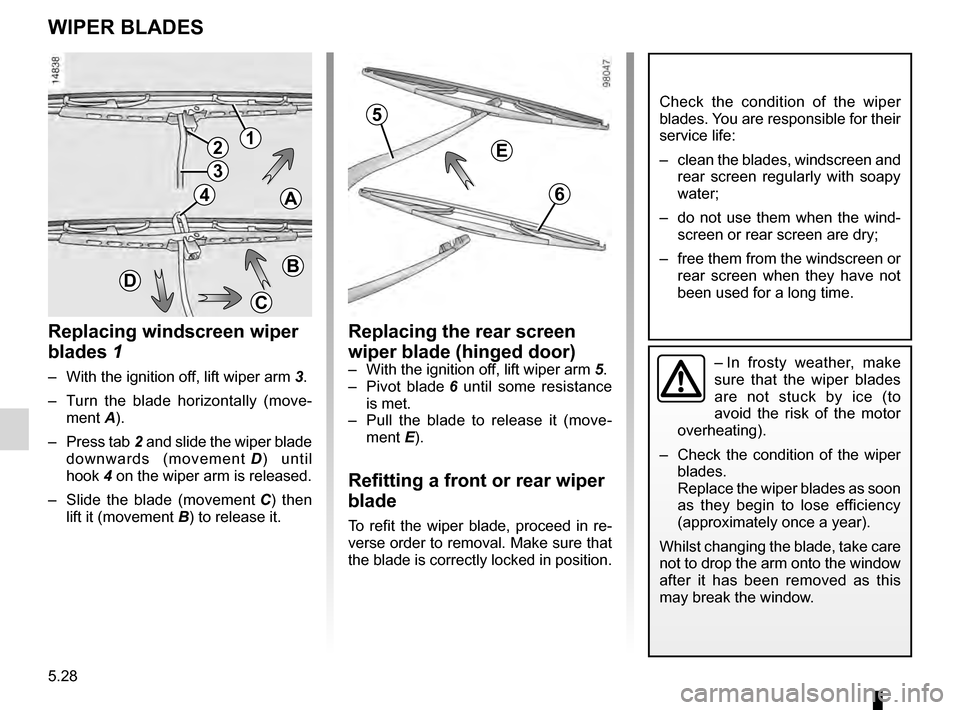
wiper blades ......................................... (up to the end of the DU)
practical advice ..................................... (up to the end of the DU)
wipers blades ............................................. (up to the end of the DU)
5.28
ENG_UD20464_6
Balais d’essuie-vitre (B90 - Dacia)
ENG_NU_817-10_B90_Dacia_5
Wiper blades
WIPER BLADES
12
3
4
Check the condition of the wiper
blades. You are responsible for their
service life:
–
clean
the blades, windscreen and
rear screen regularly with soapy
water;
–
do
not use them when the wind-
screen or rear screen are dry;
–
free
them from the windscreen or
rear screen when they have not
been used for a long time.
Replacing windscreen wiper
blades 1
– With the ignition of f, lift wiper arm 3.
–
T
urn the blade horizontally (move-
ment
A).
–
Press
tab 2 and slide the wiper blade
downwards (movement
D )
until
hook
4 on the wiper arm is released.
–
S
lide the blade (movement
C)
then
lift it (movement
B) to release it.
Replacing the rear screen
wiper blade (hinged door)
– With the ignition of f, lift wiper arm 5.
– P ivot blade 6
until some resistance
is met.
–
P
ull the blade to release it (move-
ment
E).
Refitting a front or rear wiper
blade
To refit the wiper blade, proceed in re-
verse order to removal. Make sure that
the blade is correctly locked in position.
A
C
BD
6
5
E
– In frosty weather, make
sure that the wiper blades
are not stuck by ice (to
avoid the risk of the motor
overheating).
–
Check
the condition of the wiper
blades.
Replace the wiper blades as soon
as they begin to lose efficiency
(approximately once a year).
Whilst changing the blade, take care
not to drop the arm onto the window
after it has been removed as this
may break the window.
Page 143 of 174
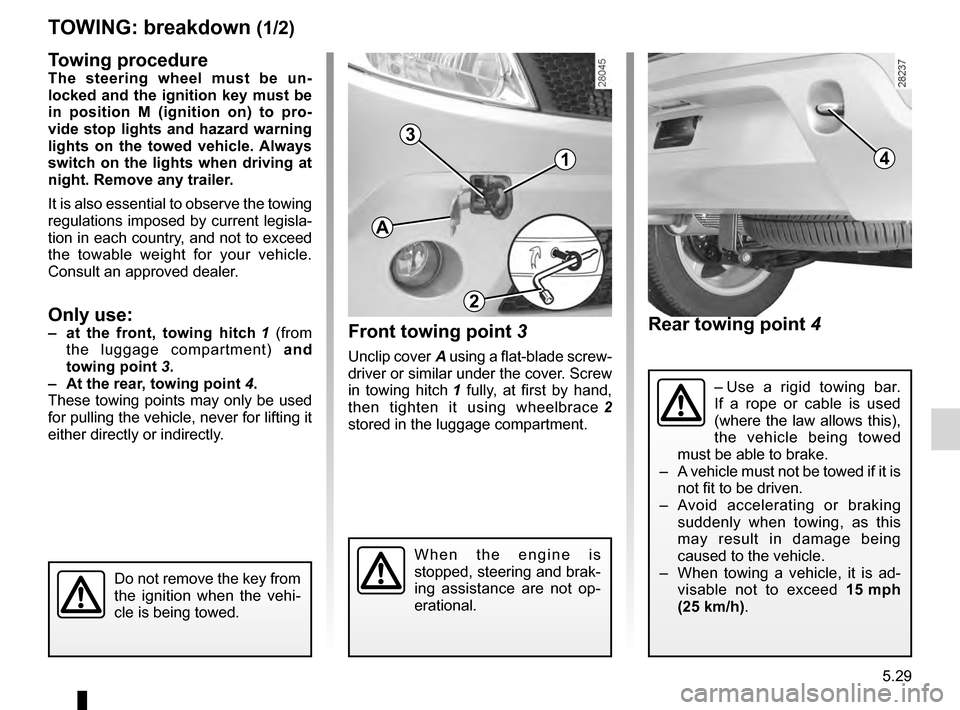
towing hitch........................................... (up to the end of the DU)
practical advice ..................................... (up to the end of the DU)
towing breakdown ...................................... (up to the end of the DU)
5.29
ENG_UD17944_4
Remorquage : dépannage (B90 - Dacia)
ENG_NU_817-10_B90_Dacia_5
Rear towing point 4
Front towing point
3
Unclip cover A using a flat-blade screw-
driver or similar under the cover. Screw
in towing hitch
1
fully, at first by hand,
then tighten it using wheelbrace
2
stored in the luggage compartment.
Towing: breakdown
W h e n t h e e n g i n e i s
stopped, steering and brak-
ing assistance are not op-
erational.
41
3
Towing procedureThe steering wheel must be un-
locked and the ignition key must be
in position M (ignition on) to pro-
vide stop lights and hazard warning
lights on the towed vehicle. Always
switch on the lights when driving at
night. Remove any trailer.
It is also essential to observe the towing
regulations imposed by current legisla-
tion in each country, and not to exceed
the towable weight for your vehicle.
Consult an approved dealer.
Only use:– at the front, towing hitch 1 (from
the luggage compartment) and
towing point
3.
–
At the rear
, towing point 4.
These towing points may only be used
for pulling the vehicle, never for lifting it
either directly or indirectly.
Do not remove the key from
the ignition when the vehi-
cle is being towed.
– Use a rigid towing bar.
If a rope or cable is used
(where the law allows this),
the vehicle being towed
must be able to brake.
–
A
vehicle must not be towed if it is
not fit to be driven.
–
A
void accelerating or braking
suddenly when towing, as this
may result in damage being
caused to the vehicle.
–
W
hen towing a vehicle, it is ad-
visable not to exceed 15
m
ph
(25
km/h).
TOWING: breakdown (1/2)
A
2
Page 144 of 174
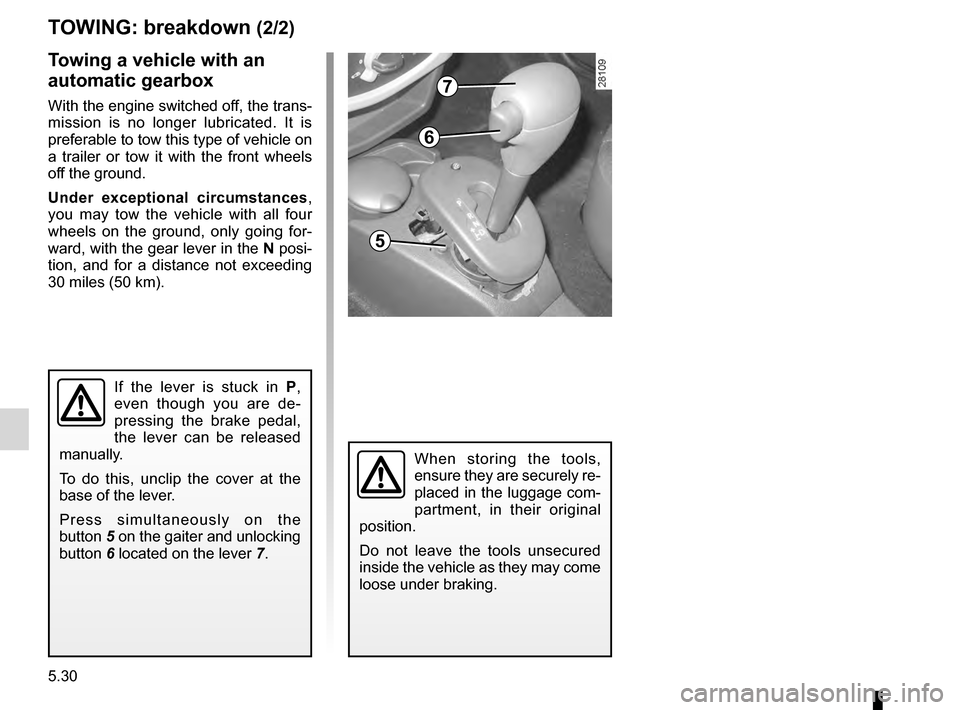
5.30
ENG_UD17944_4
Remorquage : dépannage (B90 - Dacia)
ENG_NU_817-10_B90_Dacia_5
Towing a vehicle with an
automatic gearbox
With the engine switched off, the trans-
mission is no longer lubricated. It is
preferable to tow this type of vehicle on
a trailer or tow it with the front wheels
off the ground.
Under exceptional circumstances ,
you may tow the vehicle with all four
wheels on the ground, only going for-
ward, with the gear lever in the N posi-
tion, and for a distance not exceeding
30 miles (50 km).
If the lever is stuck in P,
even though you are de-
pressing the brake pedal,
the lever can be released
manually.
To do this, unclip the cover at the
base of the lever.
P r e s s s i m u l t a n e o u s l y o n t h e
button
5 on the gaiter and unlocking
button
6 located on the lever
7
.
When storing the tools,
ensure they are securely re-
placed in the luggage com-
partment, in their original
position.
Do not leave the tools unsecured
inside the vehicle as they may come
loose under braking.
TOWING: breakdown (2/2)
7
6
5
Page 145 of 174
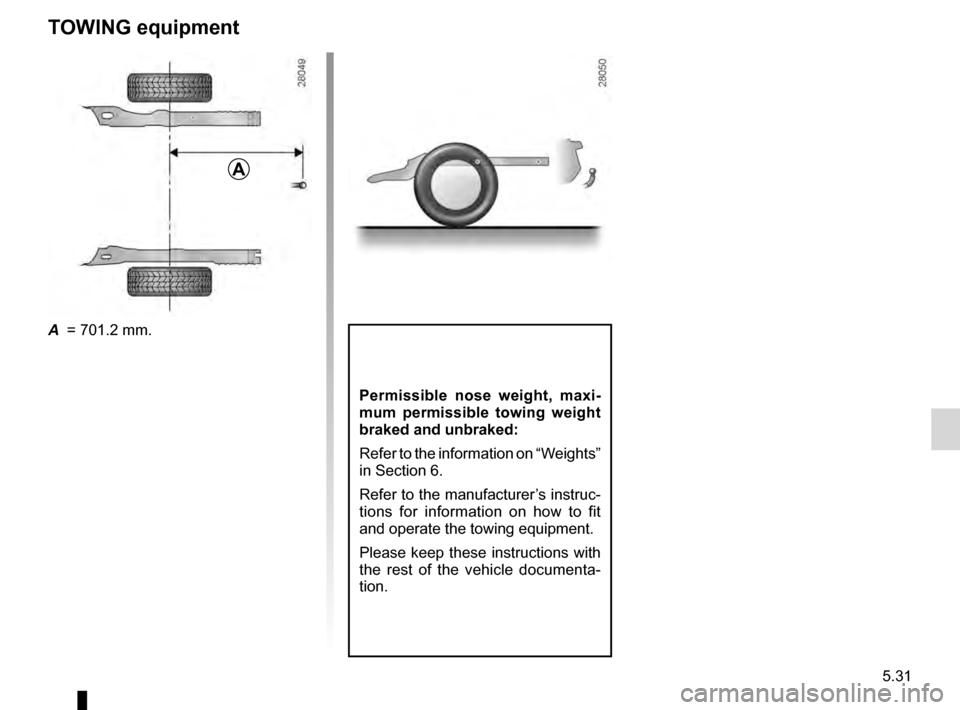
practical advice ..................................... (up to the end of the DU)
towing towing equipment ............................ (up to the end of the DU)
5.31
ENG_UD18259_3
Remorquage : attelage (B90 - Dacia)
ENG_NU_817-10_B90_Dacia_5
A = 701.2 mm.
Towing: equipment
TOWING equipment
A
Permissible nose weight, maxi-
mum permissible towing weight
braked and unbraked:
Refer to the information on “Weights”
in Section 6.
Refer to the manufacturer’s instruc-
tions for information on how to fit
and operate the towing equipment.
Please keep these instructions with
the rest of the vehicle documenta-
tion.
Page 146 of 174
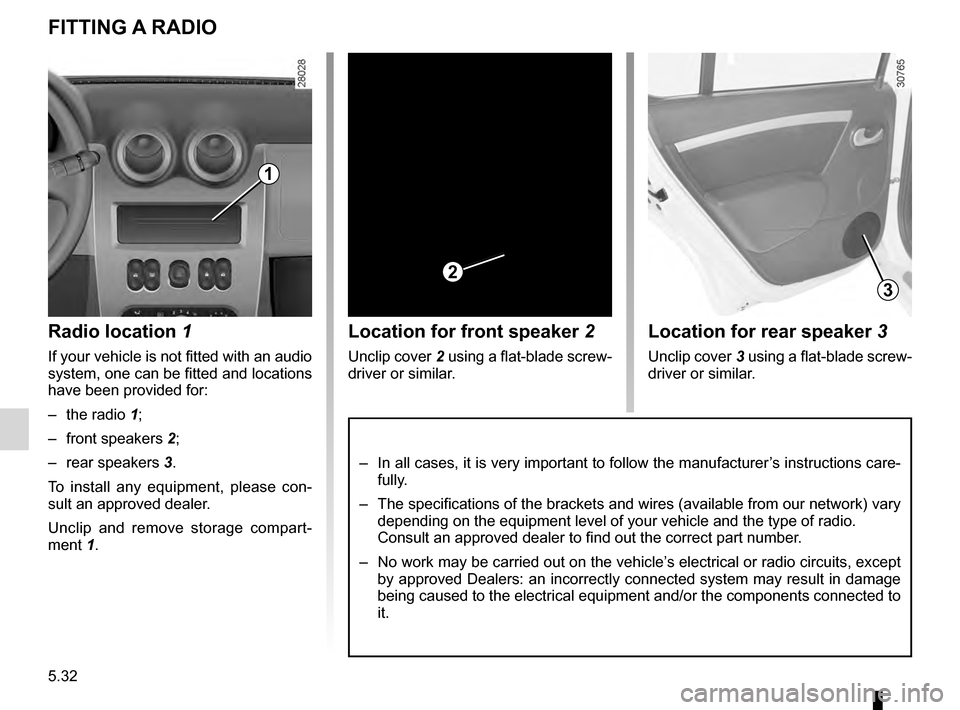
practical advice ..................................... (up to the end of the DU)
speakers location ........................................... (up to the end of the DU)
fitting a radio ......................................... (up to the end of the DU)
fitting a radio ......................................... (up to the end of the DU)
radio fitting a radio ................................... (up to the end of the DU)
5.32
ENG_UD20508_4
Prééquipement radio (B90 - Dacia)
ENG_NU_817-10_B90_Dacia_5
Fitting a radio
FITTING A RADIO
1
2
Radio location 1
If your vehicle is not fitted with an audio
system, one can be fitted and locations
have been provided for:
–
the radio
1;
–
front speakers
2;
–
rear speakers
3.
To install any equipment, please con-
sult an approved dealer.
Unclip and remove storage compart-
ment
1.
Location for front speaker 2
Unclip cover 2 using a flat-blade screw-
driver or similar .
Location for rear speaker 3
Unclip cover 3 using a flat-blade screw-
driver or similar .
– In all cases, it is very important to follow the manufacturer’s instructions care-fully.
–
The
specifications of the brackets and wires (available from our network) vary
depending on the equipment level of your vehicle and the type of radio.
Consult an approved dealer to find out the correct part number.
–
No
work may be carried out on the vehicle’s electrical or radio circuits, except
by approved Dealers: an incorrectly connected system may result in damage
being caused to the electrical equipment and/or the components connected to
it.
3
Page 147 of 174
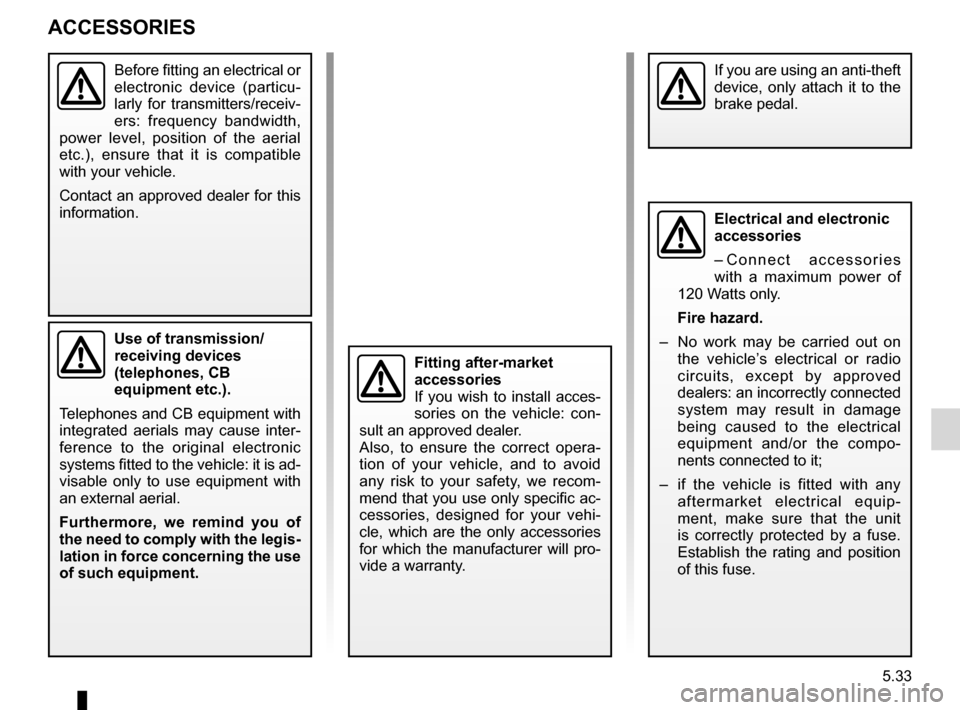
accessories........................................... (up to the end of the DU)
practical advice ..................................... (up to the end of the DU)
accessories - installation ...................... (up to the end of the DU)
5.33
ENG_UD18260_7
Accessoires (B90 - U90 - L90 Ph2 - F90 Ph2 - R90 Ph2 - Dacia)
ENG_NU_817-10_B90_Dacia_5
Accessories
ACCESSORIES
Use of transmission/
receiving devices
(telephones, CB
equipment etc.).
Telephones and CB equipment with
integrated aerials may cause inter-
ference to the original electronic
systems fitted to the vehicle: it is ad-
visable only to use equipment with
an external aerial.
Furthermore, we remind you of
the need to comply with the legis-
lation in force concerning the use
of such equipment.
Electrical and electronic
accessories
–
C
o n n e c t a c c e s s o r i e s
with a maximum power of
120
Watts only.
Fire hazard.
–
N
o work may be carried out on
the vehicle’s electrical or radio
circuits, except by approved
dealers: an incorrectly connected
system may result in damage
being caused to the electrical
equipment and/or the compo-
nents connected to it;
–
i
f the vehicle is fitted with any
aftermarket electrical equip -
ment, make sure that the unit
is correctly protected by a fuse.
Establish the rating and position
of this fuse.
Before fitting an electrical or
electronic device (particu-
larly for transmitters/receiv-
ers: frequency bandwidth,
power level, position of the aerial
etc.), ensure that it is compatible
with your vehicle.
Contact an approved dealer for this
information.
Fitting after-market
accessories
If you wish to install acces-
sories on the vehicle: con-
sult an approved dealer.
Also, to ensure the correct opera-
tion of your vehicle, and to avoid
any risk to your safety, we recom-
mend that you use only specific ac-
cessories, designed for your vehi-
cle, which are the only accessories
for which the manufacturer will pro-
vide a warranty.
If you are using an anti-theft
device, only attach it to the
brake pedal.
Page 148 of 174
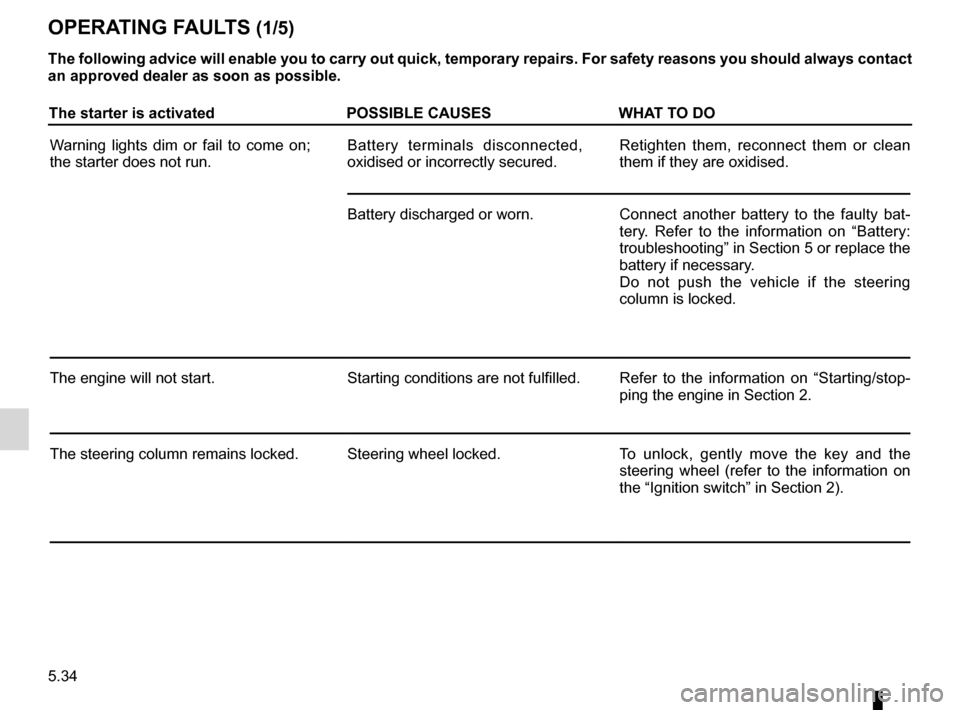
operating faults ..................................... (up to the end of the DU)
practical advice ..................................... (up to the end of the DU)
faults operating faults ............................... (up to the end of the DU)
5.34
ENG_UD19739_7
Anomalies de fonctionnement (B90 - U90 - L90 Ph2 - F90 Ph2 - R90 Ph2 - \
Dacia)
ENG_NU_817-10_B90_Dacia_5
Jaune NoirNoir texte
Operating faults
OPERATING FAULTS (1/5)
The following advice will enable you to carry out quick, temporary repairs. For safety reasons you should always contact
an approved dealer as soon as possible.
The starter is activated POSSIBLE CAUSESWHAT TO DO
Warning lights dim or fail to come on;
the starter does not run. Battery terminals disconnected,
oxidised or incorrectly secured.Retighten them, reconnect them or clean
them if they are oxidised.
Battery discharged or worn. Connect another battery to the faulty bat-
tery. Refer to the information on “Battery:
troubleshooting” in Section 5 or replace the
battery if necessary.
Do not push the vehicle if the steering
column is locked.
The engine will not start. Starting conditions are not fulfilled. Refer to the information on “Starting/stop-
ping the engine in Section 2.
The steering column remains locked. Steering wheel locked. To unlock, gently move the key and the
steering wheel (refer to the information on
the “Ignition switch” in Section 2).
Page 149 of 174
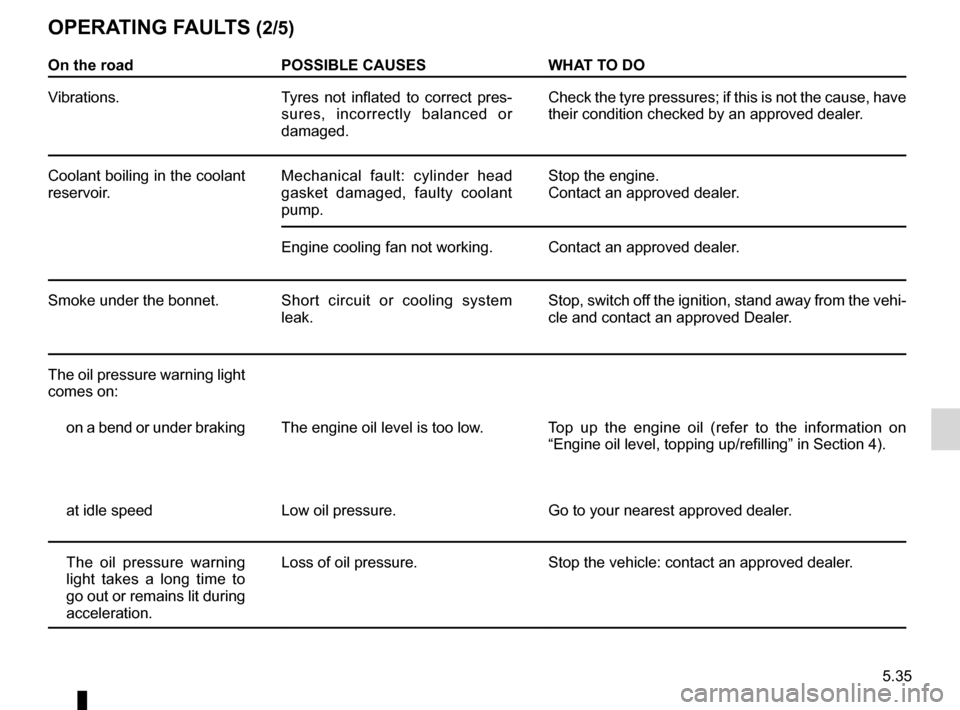
JauneNoirNoir texte
5.35
ENG_UD19739_7
Anomalies de fonctionnement (B90 - U90 - L90 Ph2 - F90 Ph2 - R90 Ph2 - \
Dacia)
ENG_NU_817-10_B90_Dacia_5
OPERATING FAULTS (2/5)
On the road POSSIBLE CAUSES WHAT TO DO
Vibrations. Tyres not inflated to correct pres-
sures, incorrectly balanced or
damaged. Check the tyre pressures; if this is not the cause, have
their condition checked by an approved dealer.
Coolant boiling in the coolant
reservoir. Mechanical fault: cylinder head
gasket damaged, faulty coolant
pump. Stop the engine.
Contact an approved dealer.
Engine cooling fan not working. Contact an approved dealer.
Smoke under the bonnet. Short circuit or cooling system leak. Stop, switch off the ignition, stand away from the vehi-
cle and contact an approved Dealer.
The oil pressure warning light
comes on: on a bend or under braking The engine oil level is too low. Top up the engine oil (refer to the information on “Engine oil level, topping up/refilling” in Section 4).
at idle speed Low oil pressure. Go to your nearest approved dealer.
The oil pressure warning
light takes a long time to
go out or remains lit during
acceleration. Loss of oil pressure.
Stop the vehicle: contact an approved dealer.
Page 150 of 174

5.36
ENG_UD19739_7
Anomalies de fonctionnement (B90 - U90 - L90 Ph2 - F90 Ph2 - R90 Ph2 - \
Dacia)
ENG_NU_817-10_B90_Dacia_5
Jaune NoirNoir texte
OPERATING FAULTS (3/5)
On the road POSSIBLE CAUSES WHAT TO DO
Abnormal white smoke from the ex-
haust Mechanical fault: damaged cylinder
head gasket.
or Stop the engine.
Contact an approved dealer.
This is not necessarily a fault.
Smoke may be caused by
regeneration of the particle filter. Refer to the information on “Special
features of diesel versions” in Section 2.
The power-assisted steering be-
comes heavy. Belt broken.
Have the belt replaced.
No power-assisted steering oil For maintenance operations on the power-
assisted steering, contact an approved
dealer.
Radiator: If there is a significant lack of coolant, remember that it must never be topped up using cold coolant while
the engine is very warm. After any procedure on the vehicle which has involved even partial draining of the cooling
system, it must be refilled with a new mixture prepared in the correct proportions. Reminder: only products approved
by the Technical Department may be used for this purpose.